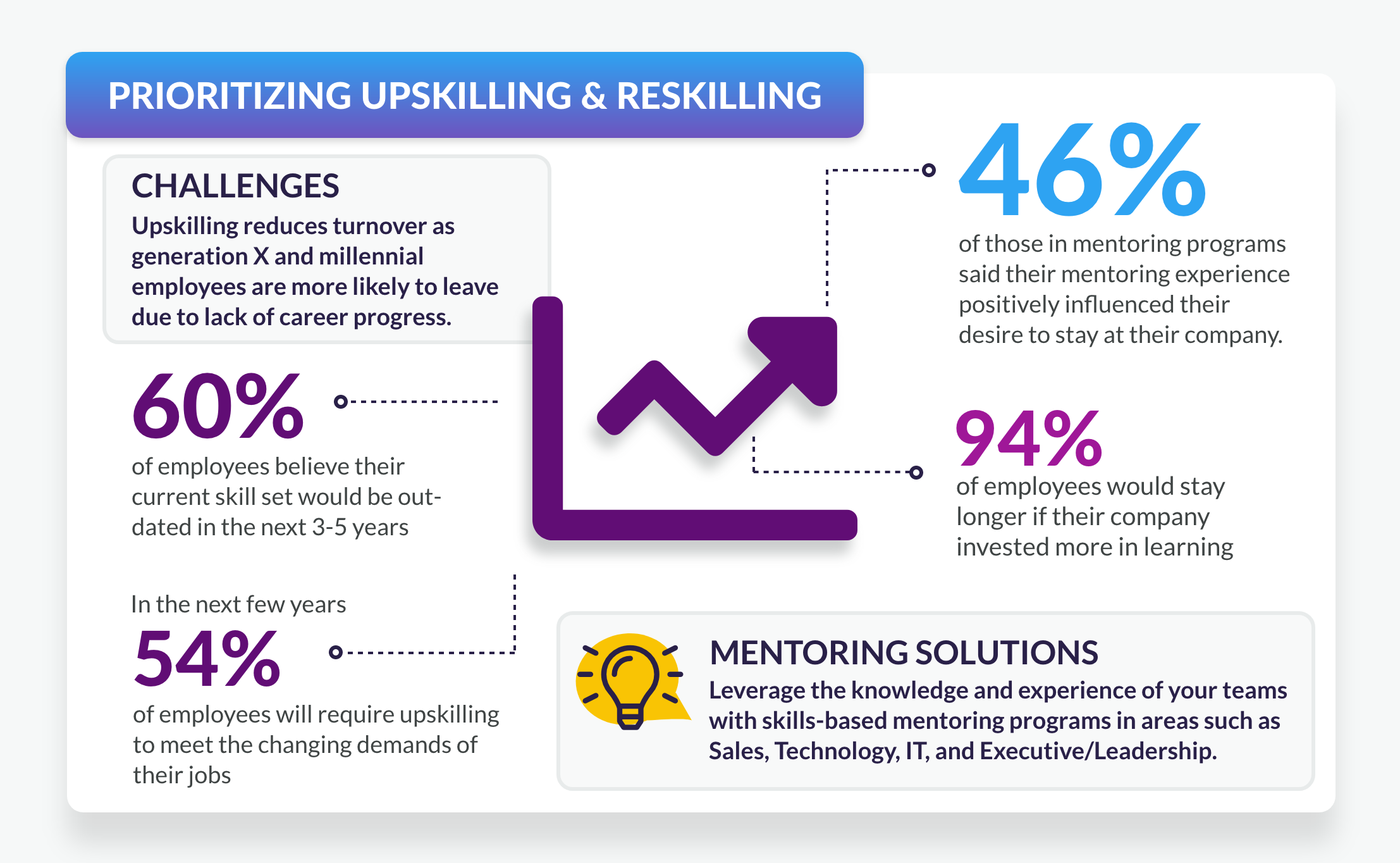Although the Great Resignation is highlighted by a high demand for workers, many people reflected on the short-term layoffs by recognizing their need to improve their skills and make themselves stronger candidates on the job market. Consequently, a key driver of the Great Resignation is people’s desire to work for a company that offers upskilling and reskilling in meaningful ways. It’s also one of the top mentoring trends for 2022 we’ve identified, which include:
- Inclusive communities at work
- Upskilling and reskilling
- Paving career pathways
As we head into 2022, companies that offer upskilling and reskilling opportunities will have an advantage in finding and keeping talent. One of the best ways to do this and reap the benefits that come with higher engagement and retention is by using mentoring programs to leverage the existing knowledge and experience of your tenured team members.
Survive 2024 with Upskilling
Download a free copy of our Workforce Survival Guide!
Trendsetting with Upskilling and Reskilling
Major economic downturns have historically become a reflection point. Workers survey the work environment, compare it against their existing skills, and often turn to the pursuit of new or improved skills to make themselves more valuable in the job market. This is exactly what happened after the Great Recession in 2008. And it’s happening right now as we work to move out of the global pandemic and its heavy influences on people’s current and future job prospects.

Workers are right to be concerned about their viability on the job market. In the next few years, 54% of employees will require upskilling to meet the changing demands of their jobs. Technology is moving at lightning speed. Jobs that aren’t being replaced by automation are being enhanced by automation tools that workers need to know how to operate. That, alone, requires upskilling (at a minimum) and for many workers, complete reskilling as they adapt to a work environment that requires them to possess skills that may not even have existed when they started their career.
As The Washington Post highlighted in a September 2021 article,
“Nationwide, most industries have more job openings than people with prior experience in that sector […]. To find enough workers, companies may need to train workers and entice people to switch careers, a process which generally takes longer, especially in fields that require special licenses.”
The more complex the job, the more difficult it will be to replace workers. That makes your existing talent all the more valuable, but also means that if your company prioritizes skills training as you’re more likely to attract the talent you want.
Mentoring Streamlines Upskilling and Reskilling
Workers recognize their need to learn; it’s not something you need to force on them. A PwC survey found that 60% of employees believe their current skill set would be outdated in the next 3-5 years. They know they need help. Positively, that help can be effectively disseminated through the organization with skills-based mentoring programs.
Here are a few skills-focused mentoring strategies to consider for 2022:
- Emphasize skills training in onboarding programs. New workers may come into the organization with skills gaps. Connect them with more experienced team members during the onboarding period to help hone their skills, and track that relationship using mentoring software.
- Create skills-based mentoring programs to uplift both new and tenured employees. Leverage the knowledge and experience your tenured members have gained by allowing them to connect with newer team members in 1-to-1 or 1-to-many mentoring relationships. Tenured team members can help newer employees hone their skills, while newer employees can take the role of the teacher and help tenured members learn new methods and strategies.
- Offer open mentoring programs for on-demand skills development. Open mentoring programs make it easier for workers to independently connect and gain skills growth or insights. Workers often recognize where their skill gaps exist. Open mentoring programs powered by mentoring software make it easier for them to find and connect with team members who can help them grow those skills and add to the strength of your team.
When workers improve their skills, everyone wins. Research from LinkedIn shows that 94% of workers would stay longer if their company invested in their learning. As far as out-of-pocket investments go, mentoring is one of the most cost-effective ways to do so, and produces some of the best ROI.
For example, companies that use MentorcliQ enjoy an average 50% improvement in their retention rate among their mentored population, saving millions of dollars in turnover costs. And that doesn’t factor in the downwind benefit of improved productivity from workers who are improving their skills across different functions.
Workers are quitting for a variety of reasons, but it seems the need to work for a company that emphasizes skills is a major factor. Our 2022 Workforce Survival Guide offers additional insight into the Great Resignation as well as strategies for how to use mentoring to help give your organization an advantage in today’s job market.




